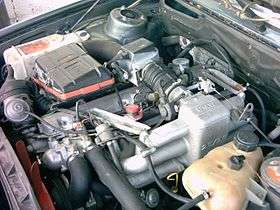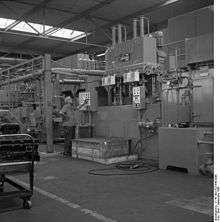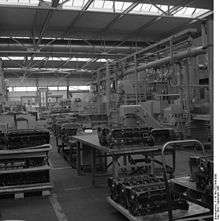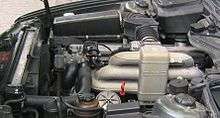BMW M30
The BMW M30 is a SOHC straight-six petrol engine which was produced from 1968 to 1995. With a production run of 27 years, it is BMW's longest produced engine and was used in many car models.
| BMW M30 engine | |
|---|---|
 | |
| Overview | |
| Production | 1968–1995 |
| Layout | |
| Configuration | Straight-6 |
| Displacement | 2.5–3.4 L (153–207 cu in) |
| Block material | Cast iron |
| Head material | Aluminium |
| Valvetrain | SOHC |
| Combustion | |
| Fuel type | Petrol |
| Chronology | |
| Predecessor | BMW M337 |
| Successor | BMW M50 |
The first models to use the M30 engine were the BMW 2500 and 2800 sedans. The initial M30 models were produced in displacements of 2,494–2,986 cc (152.2–182.2 cu in), with later versions having displacements of up to 3,430 cc (209.3 cu in).[1] As per the BMW M10 four-cylinder engine from which the M30 was developed, the M30 has an iron block, an aluminium head and an overhead camshaft with two valves per cylinder.
The engine was given the nicknames of 'Big Six' and 'Senior Six', following the introduction of the smaller BMW M20 straight-six engine in the late 1970s. The M30 was produced alongside the M20 throughout the M20's production, and prior to the introduction of the BMW M70 V12 engine in 1987, the M30 was BMW's most powerful and largest regular production engine.
Following the introduction of the BMW M50 engine in 1990, the M30 began to be phased out.
Ward's have rated the M30 as one of the "Top Engines of the 20th Century".[2]
Design
The M30 was originally developed in the late 1960s, loosely based on the BMW M10 four-cylinder engine first used in the BMW New Class sedans and coupes.[3](p70) Initially, the engine code was "M06", until it was later renamed the M30.[4][5]
Common features between the M10 and M30 include a profile lowering 30-degree slant to the right, a crossflow cylinder head (a gas flow head in later designs) and chain-driven camshaft with rocker arm valve actuation.[6] Further similarities include a cast-iron block with an aluminium head and a forged crankshaft. The first two M30 engines introduced were the 2,788 cc (170.1 cu in) and the 2,494 cc (152.2 cu in) versions, which both used an 86 mm (3.39 in) bore.[3]
M90 engine
The M90 engine, used in several models from 1979-1982, combines the block from the motorsports BMW M88 DOHC engine with the M30's SOHC cylinder head.
Versions
| Version | Displacement | Power output | Torque | Year |
|---|---|---|---|---|
| M30B25V | 2,494 cc (152.2 cu in) | 110 kW (148 bhp) at 6,000 rpm | 211 N⋅m (156 lb⋅ft) at 3,700 rpm | 1968 |
| M30B25 | 215 N⋅m (159 lb⋅ft) at 3,700 rpm | 1981 | ||
| M30B28V | 2,788 cc (170.1 cu in) | 125 kW (168 bhp) at 6,000 rpm | 235 N⋅m (173 lb⋅ft) at 3,700 | 1968 |
| M30B28 | 135 kW (181 bhp) at 5,800 rpm | 240 N⋅m (177 lb⋅ft) at 4,200 rpm | 1977 | |
| M30B30V | 2,986 cc (182.2 cu in) | 132 kW (177 bhp) at 6,000 rpm | 255 N⋅m (188 lb⋅ft) at 3,700 rpm | 1971 |
| M30B30 | 149 kW (200 bhp) at 5,500 rpm | 272 N⋅m (201 lb⋅ft) at 4,300 rpm | 1971 | |
| M30B32 | 3,210 cc (195.9 cu in) | 147 kW (197 bhp) at 5,500 rpm | 285 N⋅m (210 lb⋅ft) at 4,300 rpm | 1976 |
| M30B33V | 3,295 cc (201.1 cu in) | 139 kW (186 bhp) at 5,500 rpm | 289 N⋅m (213 lb⋅ft) at 3,500 rpm | 1973 |
| M30B34 | 3,430 cc (209.3 cu in) | 160 kW (215 bhp) at 5,800 rpm | 310 N⋅m (229 lb⋅ft) at 4,200 rpm | 1982 |
| M30B35 | 155 kW (208 bhp) at 5,700 rpm | 305 N⋅m (225 lb⋅ft) at 4,000 rpm | 1988 |
M30B25V
.jpg)
in BMW Museum


The first 2,494 cc (152.2 cu in) version of the M30 was introduced in the 1968 E3 2500. This version uses dual Solex Zenith 35/40 INAT carburettors, has a compression ratio of 9.0:1 and produces 110 kW (148 bhp) in most applications. It has a bore of 86 mm (3.39 in) and a stroke of 86 mm × 71.6 mm (3.39 in × 2.82 in).
The M30B25 has previously been called the M06 and M68, prior to BMW retroactively renaming it the M30B25V (V for Vergaser- carburettor in German).[7]
Applications:
M30B25
In 1981, Bosch L-Jetronic electronic fuel injection was added to the 2,494 cc (152.2 cu in) version. Peak power remained unchanged at 110 kW (148 bhp), however torque increased slightly to 215 N⋅m (159 lb⋅ft).
Applications:
M30B28V
The M30B28V version produces up to 125 kW (168 bhp) and 235 N⋅m (173 lb⋅ft),[3](p77) depending on the model year, carburettor and country. It has a compression ratio of 9.0:1 and initially used dual Zenith 35/40 INAT carburettors. The bore is 86 mm (3.39 in) and the stroke is 86 mm × 80 mm (3.39 in × 3.15 in).
This version has also been known as the M06 and M68, prior to BMW renaming it the M30B28V.
Applications:
- 1968-1977 E3 2800 / 2.8L — 125 kW (168 bhp)[12][13]
- 1968-1971 E9 2800 CS
- 1971-1971 E3 Bavaria — United States only
- 1974-1976 E12 528 — 121 kW (162 bhp), dual Zenith INAT carburettors[14](p89)[15][16]
- 1976-1978 E12 528 — 125 kW (168 bhp), Solex 4A1 carburettor[17](p25)
- 1977-1979 E23 728 — 125 kW (168 bhp), Solex 4A1 carburettor[18]
M30B28
In 1977, Bosch L-Jetronic electronic fuel injection was added to the 2,788 cc (170.1 cu in) version.[13] Power increased to 135 kW (181 bhp) and torque increased to 240 N⋅m (177 lb⋅ft).
M30B30V
Based on the M30B28V version with a 3 mm (0.12 in) larger bore, the M30B30V produces 132 kW (177 bhp) and 255 N⋅m (188 lb⋅ft),[21][22] uses dual Zenith 35/40 INAT carburettors and has a compression ratio of 9.0:1.
Applications:
M30B30
The fuel injected version of the 2,986 cc (182.2 cu in) M30 debuted in 1971 in the E9 3.0 CSi and initially used the Bosch D-Jetronic mechanical fuel injection system.[25] In 1976, the fuel injection system was upgraded to Bosch L-Jetronic electronic fuel injection.[25] The M30B30 produces up to 149 kW (200 bhp) and 272 N⋅m (201 lb⋅ft),[26][27] depending on the model year and whether a catalytic converter is fitted. The compression ratio is 9.5:1.
Applications:
- 1971-1975 E9 3.0 CSi — 149 kW (200 bhp)
- 1972-1973 E9 3.0 CSL — 149 kW (200 bhp)
- 1972-1975 E3 3.0 Si — 147 kW (197 bhp)
- 1975-1978 E12 530i — North America only, 131 kW (176 bhp)[28]
- 1976-1976 E12 530 MLE — South Africa only, 147 kW (197 bhp)[29]
- 1977-1978 E24 630CSi — North America only, 129 kW (173 bhp)[30]
- 1986-1995 E32 730i — 138 kW (185 bhp)[31][32]
- 1988-1990 E34 530i — 138 kW (185 bhp)
M30B32
Despite having a capacity of 3,210 cc (195.9 cu in), this engine appeared in many cars badged so as to suggest 3.3 L (201 cu in) of displacement- such as the 633i, 3.3 Li, and 733i. The compression ratio is 8.8:1. In the E24 633CSi coupe, the M30B32 uses Bosch L-Jetronic electronic fuel injection.[13] The US version used L-Jetronic from 1978 until mid-1981, changing over to Motronic digital fuel injection in June of that year. The 1979 732i is BMW's first use of Bosch's Motronic fuel injection.[33] The bore is 89 mm (3.50 in) and the stroke is 86 mm (3.39 in).
Applications:
- 1973-1975 E9 3.0 CSL — 152 kW (204 bhp), 3,153 cc (192.4 cu in)
- 1976-1984 E24 633CSi — 145–147 kW (194–197 bhp) in Euro spec, 128–130 kW (172–174 bhp) in USA spec
- 1976-1979 E3 3.3 Li — 147 kW (197 bhp)[34]
- 1977-1984 E23 733i — 147 kW (197 bhp) in Euro spec,[35] 130–145 kW (174–194 bhp) in USA spec
- 1979-1981 E12 533i — North America only, 135 kW (181 bhp)[36]
- 1979-1986 E23 732i — 144 kW (193 bhp)
- 1982-1984 E28 533i — North America only, 135 kW (181 bhp)
- 1984-1986 E30 333i — South Africa only, 145 kW (194 bhp)
M30B33V
The carburetted M30B33 produces 139 kW (186 bhp) and 289 N⋅m (213 lb⋅ft).[37] It has a bore of 89 mm (3.50 in) and a stroke of 88 mm (3.46 in).
Applications:
M30B34
The M30B34 engines sold in Europe and most other markets used a 10.0:1 compression ratio and produced 160 kW (215 bhp).[39] In North America and Japan, the M30B34 used an 8.0:1 compression ratio and produced 136 kW (182 bhp).[40] In all markets, the Bosch Motronic digital fuel injection system was used. The bore is 92 mm (3.62 in) and the stroke is 86 mm (3.39 in).
Applications:
M30B35

This engine has a capacity of 3,430 cc (209.3 cu in), despite the "B35" model code. It produces 155 kW (208 bhp) and 305 N⋅m (225 lb⋅ft), has a compression ratio of 9.0:1 and uses Bosch Motronic 1.3 digital fuel injection.[13]
Applications:
Turbocharging
The M30 was the basis for the turbocharged M102 and M106 engines.
The Alpina B10 Biturbo used a modified version of the M30, with two turbochargers and forged pistons. Producing 265 kW (355 bhp) at 6000 rpm and 520 N⋅m (384 lb⋅ft) at 4000 rpm, the engine made this car the fastest sedan in the world. The final 50 M30 blocks were shipped to Alpina for use in the final 50 B10 Biturbos.[44]
M102
The M102 was produced from 1980 to 1982. It was BMW's first turbocharged six-cylinder engine.
The M102 (also known as M30B32LAE)[45] has a displacement of 3,210 cc (195.9 cu in).[46] The KKK K27 turbocharger produces 9 psi (0.62 bar) of boost[47] and an air-to-air intercooler is used.[48] The compression ratio is 7.0:1.[49]
The M102 produces 188 kW (252 bhp)[50] and was used in the E23 7 Series, in the model was designated "745i".[50] The M102 was not available in right-hand drive cars, leading to the South African 745i using the BMW M88 naturally aspirated DOHC straight-six engine instead.
Applications:
- 1980–1982 E23 745i
M106
The M106 (also called M30B34MAE) replaced the M102 and was produced from 1982 to 1986.
Some of the M106's upgrades over its predecessor are a result of the M30B34 version of the M30, which was also released in 1982. These upgrades include Bosch Motronic engine management and an increased displacement to 3,430 cc (209.3 cu in). The compression ratio was increased from 7.0:1 to 8.0:1.[51][52]
Peak power output is the same 185 kW (248 bhp) as the M102,[53] however it occurs at lower RPM[52] and peak boost is reduced from 9 to 6 psi (0.62 to 0.41 bar).[54]
There was no direct successor to the M106, however BMW's next turbocharged petrol engine was the BMW N54, introduced in 2006.
Applications:
- 1982-1986 E23 745i
Motorsport
The M30 powered a series of E9 CSL and E24 6 Series coupes to European Touring Car Championship (ETCC) throughout the 1970s and into the middle 1980s, even though a more powerful DOHC 24-valve head had been developed for high-performance motorsports and street use.
The BMW M88 high-performance engine is based on the M30 block.[55]
See also
| Wikimedia Commons has media related to BMW M30 engine. |
- BMW
- BMW M10, the four-cylinder engine that the M30 was based on.
- BMW M20, the smaller straight-six engine which was sold alongside the M30 for many years.
- BMW M88, the high-performance straight-six engine that was sold alongside the M30 from 1978-1989
- BMW S38, the catalyzed version of— and ultimately the successor to— the M88, which was sold alongside the M30 from 1986-1995.
- List of BMW engines
References
- "Bmw Engine and Powerplant Identification Codes". www.rtsauto.com. Retrieved 8 September 2017.
- "Ward's 10 Best Engines include 2 BMW sixes". www.pacemotors.com.au. Archived from the original on 22 May 2007.
- Becker, Clauspeter (1971), Logoz, Arthur (ed.), "BMW 2500/2800", Auto-Universum 1971 (in German), Zürich, Switzerland: Verlag Internationale Automobil-Parade AG, XIV
- "Bow Down To The E28 M5; Performance Cars Would Be Nothing Without It". www.carthrottle.com. Retrieved 1 December 2018.
- "The Beginning of a Legacy – A BMW Motor Evolution". www.drive4corners.com. Retrieved 1 December 2018.
- Cranswick, Marc (2010). The BMW 5 series and X5: a history of production cars and tuner specials, 1972-2008. Jefferson, NC: McFarland. ISBN 0786443510.
- "Easter Special: History of BMW motorsport, inc the factory 959BHP M30". www.bimmernut.com. Archived from the original on 26 November 2012.
- "BMW 7 Series (E23) 1977 - 1986". www.autoevolution.com. Retrieved 1 September 2017.
- "1981 BMW E28 525i Technical Specifications". www.ultimatespecs.com. Retrieved 1 September 2017.
- "1981 bmw E23 725i Technical Specifications". www.ultimatespecs.com. Retrieved 1 September 2017.
- "1986 BMW 725i (model up to mid-year 1986 for Europe ) specifications". www.automobile-catalog.com. Retrieved 1 September 2017.
- "1975 BMW 2.8 L E3 specifications & stats". www.carfolio.com. Retrieved 29 December 2018.
- Oswald, Werner (2001). Deutsche Autos 1945-1990, Band 4 (1 ed.). Stuttgart: Motorbuch Verlag. ISBN 3-613-02131-5.
- Betriebsanleitung 518, 520, 525, 528, 520i. BMW. 15 January 1975. Retrieved 29 December 2018.
- "1974 BMW E12 5 Series 528 Technical Specifications". www.ultimatespecs.com. Retrieved 1 September 2017.
- "1974 BMW 528 (model since mid-year 1974 for Europe Australia ) specifications". www.automobile-catalog.com. Retrieved 1 September 2017.
- Fahrzeugprospekt 518 520 520i 525 528. BMW. January 1977. Retrieved 29 December 2018.
- "1977 BMW 728 E23 specifications & stats". www.carfolio.com. Retrieved 29 December 2018.
- "1977 BMW E12 5 Series 528i Technical Specs". www.ultimatespecs.com. Retrieved 9 December 2018.
- "1981 BMW 528i E28". www.carfolio.com.
- "1971 BMW 3.0 S (model since April 1971 for Europe Australia ) specifications". www.automobile-catalog.com. Retrieved 1 September 2017.
- "1971 BMW E9 3.0 CS Technical Specifications". www.ultimatespecs.com. Retrieved 1 September 2017.
- "1976 BMW 630 CS E24". www.carfolio.com. Retrieved 1 September 2017.
- "BMW 730, 1977 MY E23". www.carfolio.com. Retrieved 1 September 2017.
- "The BMW Six Cylinder Guide". www.autospeed.com. Retrieved 8 September 2017.
- "1972 BMW 3.0 CSi E9". www.carfolio.com. Retrieved 1 September 2017.
- "1972 BMW E9 3.0 CSi Specs". www.ultimatespecs.com. Retrieved 1 September 2017.
- "1974 BMW E12 5 Series 530i(USA) Specs". www.ultimatespecs.com. Retrieved 1 September 2017.
- "1976 BMW 530 MLE E12". www.carfolio.com. Retrieved 1 September 2017.
- "1976 BMW 630 CSi E24". www.carfolio.com. Retrieved 1 September 2017.
- "BMW 730i 6-cyl. (E32)". bmw-grouparchiv.de. Retrieved 14 August 2019.
- "1992 7 Series User Manual". bmw-grouparchiv.de. Retrieved 9 December 2018.
- "BMW M30 and M102 Six Cylinder Engines". www.unixnerd.demon.co.uk. Retrieved 1 September 2017.
- "1977 BMW 3.3 Li (model up to mid-year 1977 for Europe ) specifications". www.automobile-catalog.com. Retrieved 1 September 2017.
- "BMW 733i, 1977 MY E23". www.carfolio.com. Retrieved 1 September 2017.
- "1984 BMW 533i (model since mid-year 1983 for North America U.S.) specifications". www.automobile-catalog.com. Retrieved 1 September 2017.
- "1973 BMW 3.3L E3 specifications". www.carfolio.com. Retrieved 1 September 2017.
- "E3 3.3L model selection". www.realoem.com. Retrieved 1 September 2017.
- "1985 BMW E28 5 Series M535i Specs". www.ultimatespecs.com.
- "1985 BMW E28 5 Series M535i Kat Specs". www.ultimatespecs.com.
- BMW 7' [E32] Pressevorstellung. BMW. 8 September 1986. Retrieved 30 December 2018.
- "BMW E32 7 Series 735i Technical Specs, Dimensions". www.ultimatespecs.com. Retrieved 2018-12-29.
- Büschi, Hans-Ulrich, ed. (March 9, 1989). Automobil Revue 1989 (in German and French). 84. Berne, Switzerland: Hallwag AG. p. 498. ISBN 3-444-00482-6.
- Palevsky, Alexander. "Blown Away". Bimmer Magazine (October 2007): 62.
- "Archived copy". Archived from the original on 2013-11-15. Retrieved 2012-08-18.CS1 maint: archived copy as title (link)
- http://www.bmwheaven.com/database/engine.php?type=M30#/131
- http://www.uniquecarsandparts.com.au/car_info_bmw_745i_turbo.htm
- "The BMW Six Cylinder Guide". www.autospeed.com.
- "BMW 745i E23 Turbo". www.uniquecarsandparts.com.au. Retrieved 16 September 2017.
- Michael Knowling (2004-04-26). "2004 Engine Epic - BMW Engines". AutoSpeed. Web Publications Pty Limited. Archived from the original on 9 May 2008. Retrieved 2008-05-01.
- "The BMW Six Cylinder Guide". www.autospeed.com.
- http://paultan.org/2008/01/24/the-m102-m106-in-the-bmw-745i-turbo/
- http://www.bmwheaven.com/database/engine.php?type=M30#/135
- https://www.uniquecarsandparts.com.au/car_info_bmw_745i_turbo
- "FAQ E23 745i SA (M88)". www.bmwmregistry.com. Retrieved 1 September 2017.